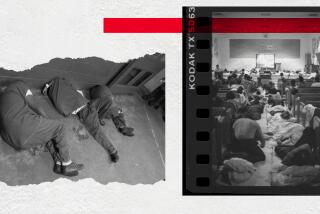State Mulling Bill on Bunk Bed Safety
- Share via
Lynn Starks-Williams turns away at the sight of bunk beds.
Her lasting image of them froze in April 1997, when she walked into her daughter’s bedroom and found Whitney, 3, strangled between her bunk bed’s frame and guardrail.
After learning that the bed’s maker had ignored furniture industry guidelines that could have saved her daughter’s life, the Oklahoma City mom campaigned relentlessly until her state voted to make voluntary bunk bed standards the law.
Consumer advocates are now pressing to extend Starks-Williams’ crusade to a second state--California. The state Assembly has approved a bill that bans unsafe bunk beds and punishes violators with fines. The Senate is scheduled to vote on the measure next week.
“We’ve seen time and again that manufacturers come into the bunk bed market who do not meet the voluntary standard,” said Mary Ellen Fife, general counsel for the Consumer Federation of America. “It needs to be mandatory. You ought to be able to put your kid to bed at night, walk out, shut the door and know they are in no danger.”
Since 1990, at least 89 children have died from bunk bed-related injuries, Consumer Product Safety Commission records show. In most cases, victims slipped into spaces between the mattress or bed frame and the guardrail that were small enough to trap their heads.
The agency also has received dozens of chilling reports about close calls: In 1995, a 4-year-old in Campbell, Calif., was discovered dangling through a bunk bed railing by his 6-year-old brother, who held him up long enough for help to come.
The CPSC has instigated 48 recalls of more than 600,000 wood and metal bunk beds since 1994, including at least a dozen that involved California manufacturers.
If California passes its bunk bed bill, it may beat the federal government to the regulatory punch by only a few months. The CPSC is expected to decide whether to enact a national bunk bed rule by year’s end that would allow the government to sue and fine violators and to stop noncompliant, foreign-made beds from entering the U.S.
California activists and legislators say they are pushing the state bill, which would punish violators with fines of up to $1,000, to safeguard consumers should the federal effort stall.
“Any time you can prevent children from losing their lives or being injured, you need to move fast,” said Assemblywoman Lynne Leach (R-Walnut Creek), the bill’s author. “We want to send a signal to the feds.”
Despite the persistent recurrence of bunk bed recalls into the late ‘90s, federal rules compelled the CPSC to give the furniture industry’s voluntary standards a chance before enacting mandatory regulations.
The industry first adopted bunk bed guidelines in 1979. The latest version, set in 1996, called for guardrails on upper bunks and openings of no more than 3.5 inches in headboards and footboards and between the guardrail and frame. Beds made since 1996 also have a permanent label that warns that children under the age of 6 should not be placed on the upper bunk.
The American Furniture Manufacturers Assn., the trade group for bunk bed makers, said the voluntary code works well enough--90% of the 500,000 U.S.-made bunk beds sold each year are in compliance, group leaders said. The organization has not formally opposed efforts to make the rules mandatory, but its leaders doubt such measures will make a difference.
“Is a mandatory standard going to get at that last 10%?” asked Joe Ziolkowski, the association’s vice president of technical services. “Even with a mandatory standard, the people who are going to cheat will cheat.”
Regulators agree that major manufacturers largely comply with the rules, but say fly-by-night operators continue to sell substandard beds. In early 1998, CPSC inspectors checked bunk beds at 55 retail stores nationwide, turning up noncompliant models made by 23 manufacturers.
“We still find them on the Internet and in high-end catalogs too,” CPSC Chairwoman Ann Brown said. “We’ve tried enormous recalls and the voluntary standard. A mandatory standard is the one remaining tool we have.”
Similar mandatory standards for infant cribs have helped reduce crib-related deaths from about 200 a year to 50, CPSC said.
Many major companies among the nation’s 160 bunk bed makers say they support mandatory safety rules as long as they are consistent from state to state. Even for companies that would have to alter products and packaging, a CPSC analysis estimated that adhering to the standard adds as little as $15 to the cost of a bunk bed.
Executives at La Mirada-based Catalina Furniture said the California proposal could help restore consumer confidence in bunk bed safety. Catalina, the West’s largest bunk bed manufacturer, recalled 5,000 wood bunk beds in 1995, but said it has met the voluntary standard since then.
“Anything that promotes the safety of these products is a necessity,” said Pam Julien, Catalina’s vice president of sales and marketing. “There are low-end manufacturers here and in Mexico that should not be allowed to sell their products.”
Since Oklahoma passed its law last year, Starks-Williams’ friends have taken to touring children’s furniture stores, checking out bunk beds, reporting back that they meet the prescribed measurements. She herself stays away, pouring her energy into the state and federal initiatives that might spare other parents similar pain.
“Everybody says there’s closure,” she said. “That might be my closure.”
(BEGIN TEXT OF INFOBOX / INFOGRAPHIC)
Bunk Bed Safety
Improper space between the guardrail and the bed frame allows a child’s body to pass through feet first, trapping the head and leaving the child suspended.
Space should be 3 1/2” or less
Add boards to close space
Source: Consumer Product Safety Commission
More to Read
Inside the business of entertainment
The Wide Shot brings you news, analysis and insights on everything from streaming wars to production — and what it all means for the future.
You may occasionally receive promotional content from the Los Angeles Times.










